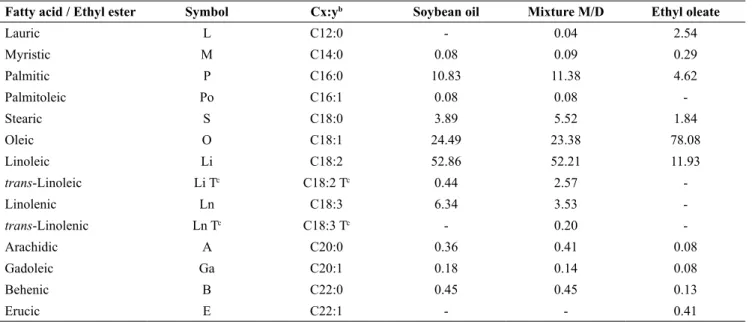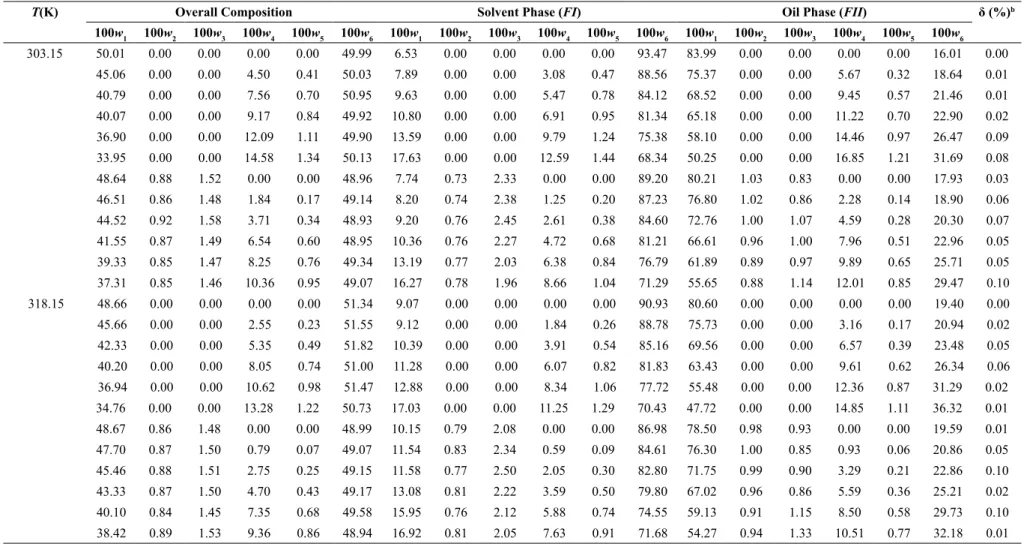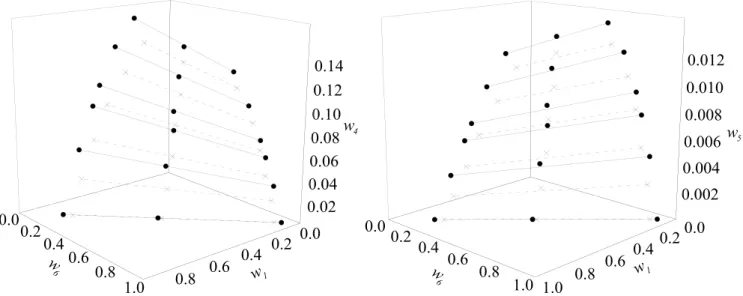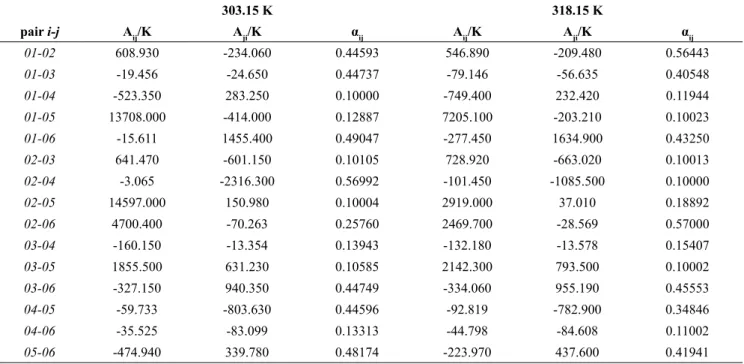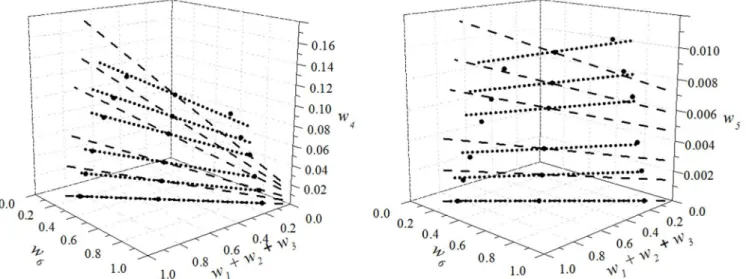of Chemical
Engineering
ISSN 0104-6632 Printed in Brazil www.scielo.br/bjce
Vol. 35, No. 02, pp. 373 - 382, April - June, 2018 dx.doi.org/10.1590/0104-6632.20180352s20160271
LIQUID-LIQUID EQUILIBRIUM OF SYSTEMS
COMPOSED OF SOYBEAN OIL +
MONOACYLGLYCEROLS +
DIACYLGLYCE-ROLS + ETHYL OLEATE + OLEIC ACID +
ETHA-NOL AT 303.15 AND 318.15 K
Larissa C. B. A. Bessa
1, Eduardo A. C. Batista
1and Antonio J. A.
Meirelles
1,*1Laboratory of Extraction, Applied Thermodynamics and Equilibrium, Department of Food Engineering, University of Campinas - Campinas/SP, Brazil, CEP: 13083-862.
(Submitted: April 28, 2016; Revised: February 16, 2017; Accepted: April 5, 2017)
Abstract - Steady increase in prices of petroleum-based fuels and growing environmental concerns are boosting attention to alternative fuels. In this context, biodiesel has drawn attention as an alternative fuel, especially as a substitute to traditional diesel. Biodiesel is commonly produced from triacylglycerols and alcohol through
transesterification reaction. Knowledge of equilibrium phase distribution of key components in transesterification
systems is essential for a better understanding of the reaction pathway and for guiding the design and optimization of reactors and the products separation. This study reports experimental results and thermodynamic modeling of the liquid-liquid equilibrium of systems composed of soybean oil + monoacylglycerols + diacylglycerols + ethyl oleate + oleic acid + ethanol at 303.15 and 318.15 K. Experimental data were well correlated using NRTL, with a maximum deviation of 0.688%. As for UNIFAC, the deviations between predicted and experimental data ranged from 3.13 to 9.21%.
Keywords: partial acylglycerols; biodiesel; ethanol; modeling.
INTRODUCTION
Recent concerns over diminishing fossil fuel su-pplies and rising oil prices, as well as adverse envi-ronmental and human health impacts from the use of petroleum fuel, have prompted considerable interest in research and development of fuels from renewable resources (West et al., 2008). Biofuels are renewable fuels derived from biomass that can replace, partially or completely, petroleum-derived fuels in engines.
Biodiesel is defined as a mixture of fatty acid alkyl
esters commonly produced from triacylglycerols and
a short-chain alcohol through a transesterification
reaction in the presence of catalysts (Knothe et al.,
2005). Transesterification leads to high conversion of
triacylglycerols (TAG) into ethyl esters (Marjanovic
et al., 2010) with diacylglycerols (DAG) and mo-noacylglycerols (MAG) as reaction intermediates and glycerol as product. Indeed, the overall process is a sequence of three consecutive steps, which are
reversible reactions. In the first step, DAGs are obtai -ned from TAGs; MAGs are then produced from DAGs and, in the last step, glycerol is obtained from MAGs. In all these reactions, ethyl esters are produced. Concentrations of DAG and MAG intermediates rise initially, passing through respective maxima, and de-cline. Stoichiometrically, the reaction requires a molar ratio alcohol:oil of 3:1, but excess alcohol is usually added to drive the reaction towards the products (West
et al., 2008; Mazutti et al., 2013). Methanol is the most commonly used alcohol, which is mainly produced by oxidation processes of methane. Ethanol, however, is preferable due to its superior dissolving power for vegetable oils, low toxicity and its renewable origin (Richard et al., 2013).
The transesterification system is complex due to
changing phase equilibria: two immiscible phases are present at the beginning (vegetable oil and ethanol), then a single phase appears after a few minutes of reaction. Finally, two phases are obtained at the end of the reaction, composed principally of ethyl esters and glycerol (Richard et al., 2013). Hence, to properly design a continuous process, numerous data must be acquired.
Liquid-liquid equilibrium (LLE) data on systems composed of mixtures of triacylglycerols, fatty acids,
alcohol, alkyl esters and glycerol are largely available
in the literature, but data on systems involving partial
acylglycerols are still scarce. In the present work, the
LLE database was extended by providing information
related to systems involved in reactive and purification
steps of the ethylic biodiesel production. Furthermore, the experimental data were used to adjust the NRTL binary interaction parameters and to evaluate two
di-fferent sets of parameters for the original UNIFAC
model.
MATERIALS AND METHODS
Suppliers and mass fraction purities of the
sol-vents and fatty compounds used in this work are lis -ted in Table 1; none of them was subjec-ted to further
purification.
Experimental procedures
All fatty compounds used in this work were
analyzed by gas chromatography of the fatty acid
me-thyl esters, according to the official method Ce 1f−62
of the American Oil Chemists’ Society (AOCS, 2009) to determine their fatty acid composition. Prior to the chromatographic analysis, the fatty samples were pre-pared in the form of fatty acid methyl esters according
to Hartman and Lago (1973). The chromatographic analysis was carried out using a capillary gas chroma-tography system under the same experimental condi-tions shown in Hirata et al. (2013). The composition of the commercial ethyl oleate was also determined by gas chromatography. The analyses were carried out in triplicate.
From the fatty acid compositions, the probable triacylglycerol compositions of soybean oil could be determined, using the statistical algorithm suggested by Antoniosi Filho et al. (1995), ignoring triacylglyce-rols with a total concentration less than 0.5 wt.%. For the mixture M/D, the probable TAG composition was determined using the same procedure and, from this composition, the compositions in mono- and diacyl-glycerols were estimated considering the probability of the partial rupture of the triacylglycerols without
preference for specific ester bonds.
LLE data for the systems (soybean oil + ethyl ole-ate + oleic acid + ethanol) and (soybean oil + mix-ture M/D + ethyl oleate + oleic acid + ethanol) were studied at 303.15 and 318.15 K, at atmospheric pres-sure. These data were measured using sealed
heads-pace glass tubes (10 mL) (PerkinElmer), as described
by Basso et al. (2012). Components were weighted on an analytical balance (Precisa, model XT220A, Sweden, ±0.0001 g). The tubes were vigorously stir-red for 30 min using a vortex (IKA, model Genius3) and then all systems were left to rest for at least 36 hours at constant temperature in a thermostatic bath with temperature control (Cole Parmer, model
12101-55, USA, ±0.01 K). Two clear layers and a well-defi -ned interface were formed when the systems reached the equilibrium state. Samples of both phases were Table 1: Reagents and fatty compounds – suppliers and purity.
Component Supplier Mass fraction
puritya
Ethanol Merck > 0.995
Toluene HPLC grade
Sigma Aldrich > 0.999
Acetic acid Merck > 0.998
Soybean oil Cargill > 0.999b
Mixture M/Dc SGS Agriculture and Industry Ltd.
> 0.52d
C o m m e r c i a l ethyl oleate
Tecnosyn > 0.75
a As reported by the supplier b of fatty compounds
and 318.15 K
carefully collected with syringes and diluted directly
with toluene for quantification of the components. The compounds of each phase were identified and quanti
-fied by size exclusion chromatography conducted in
a HPLC (High-Performance Liquid Chromatography) Shimadzu, model 20AT, under the same experimental conditions shown in Bessa et al. (2015). These analy-ses were also performed in triplicate.
The quantitative analysis was performed using ca-libration curves obtained using solutions made with the same components used in the equilibrium
syste-ms. The data obtained were fitted by linear regression
and the corresponding equations were generated for
quantification. In order to check the quality of the LLE
results, the procedure developed by Marcilla et al.
(1995) and applied to fatty systems by Rodrigues et al.
(2005) was used. According to Marcilla et al. (1995) deviation values in the global mass balance lower than 0.5% guarantee the quality of the experimental data.
Thermodynamic modeling
The experimental data were used to adjust the NRTL binary interaction parameters. The adjustments were made by treating the systems as a pseudoquater-nary (soybean oil + ethyl oleate + oleic acid + ethanol) or pseudosenary (soybean oil + mixture M/D + ethyl oleate + oleic acid + ethanol). For each system pseu-docomponents with the average molar masses of the triacylglycerols, diacylglycerols, monoacylglycerols and ethyl esters were considered. Lanza et al. (2007) and Basso et al. (2012) validated this approach when studying the LLE of systems containing soybean oil and ethylic biodiesel from crambe oil, respectively.
Estimation of the NRTL parameters was performed by minimizing the objective function of compositions, shown in Equation (1), using the simplex method, ac-cording to the procedure suggested by Stragevitch and D’ávila (1997):
The average deviations between experimental and calculated compositions in both phases were calcula-ted according to Equation (2):
(1)
where D is the total number of data sets, N is the total number of tie lines, P is the total number of pseudo-components in each data set; i, n, and m stand for com-ponent, tie line and data group, respectively; FI and
FII refer to phases I and II, respectively; exp and calc
stand for experimental and calculated mass fractions (w), respectively, σw FI and σw FII are the standard de-viations observed in the composition of the two liquid phases. The equilibrium compositions were calcula-ted using the average value between the experimental equilibrium compositions.
inm inm
(2)
The UNIFAC thermodynamic model was also used to predict the LLE of the systems. Two sets of inte-raction parameters were used: (i) UNIFAC-LLE, pro-posed by Magnussen et al. (1981), and (ii) UNIFAC-HIR, presented by Hirata et al. (2013), who adjusted UNIFAC parameters for the systems present in the oil
deacidification, i.e., systems composed of vegetable
oil + fatty acid + ethanol + water. In both cases, the model used was that presented by Fredenslund et al.
(1975). In this case, all individual components – tri-, di- and monoacylglycerolstri-, and ethyl esters – were considered for modeling calculations. The average deviation between calculated and experimental com-positions in both phases was also calculated according to Equation (2). Although the equilibrium calculations
take into account the diversity of components present
in every pseudocomponent, it should be noted that the objective function and the deviation calculation were based on the composition of the whole pseudocompo-nents, since the experimental information is available only in this form. This means that phase equilibrium is
evaluated taking into account all the main components
and then the sets of compositions of TAGs, DAGs, MAGs and esters are summed in each phase in order to obtain the compositions of the pseudocomponents.
RESULTS AND DISCUSSION
LLE experimental data
The fatty acid compositions of soybean oil and commercial mixture M/D are shown in Table 2, as well as the composition of ethyl esters of commercial ethyl oleate. Table 3 shows the probable TAG composition of soybean oil and Table 4 is the probable composition of TAG, DAG and MAG of the mixture M/D.
Fatty compounds used were also preliminarily analyzed by size exclusion chromatography (HPSEC). Through this analysis, it was possible to identify the classes of components present in each compound. Thus, it was observed that commercial mixtures M/D, in addition to these components, also contain a small amount of triacylglycerols. Among all the fatty
com-pounds used, only ethyl oleate presented a significant
content of fatty acids, which was determined by
IUPAC (1987) with an automatic buret (Metrohm, Model Dosimat 715). This analysis was replicated three times and the average value is 8.43% by weight, expressed as oleic acid.
The composition expressed in terms of mono-, di-, and triacylglycerols of the commercial mixture M/D
was obtained using gas chromatography, with flame
ionization detector according to the standard test me-thod ASTM D6584 (2013) of the American Society for Testing and Materials, obtaining the result of 5.26%,
34.86% and 59.89% of TAG, DAG and MAG, respec-tively, expressed in mass percentage.
Despite being small, the composition of TAG in the
mixture M/D was taken into account in both the expe -rimental data and in the thermodynamic calculations. However, in the case of the NRTL model, the molar mass of the representative TAG was calculated consi-dering only the molar composition of the vegetable oil. According to Table 3, the value was 872.71 g.mol-1.
It is important to mention that the error introduced Table 2: Fatty acid composition of fatty reagents (% mass)a.
Fatty acid / Ethyl ester Symbol Cx:yb Soybean oil Mixture M/D Ethyl oleate
Lauric L C12:0 - 0.04 2.54
Myristic M C14:0 0.08 0.09 0.29
Palmitic P C16:0 10.83 11.38 4.62
Palmitoleic Po C16:1 0.08 0.08 -
Stearic S C18:0 3.89 5.52 1.84
Oleic O C18:1 24.49 23.38 78.08
Linoleic Li C18:2 52.86 52.21 11.93
trans-Linoleic Li Tc C18:2 Tc 0.44 2.57 -
Linolenic Ln C18:3 6.34 3.53 -
trans-Linolenic Ln Tc C18:3 Tc - 0.20 -
Arachidic A C20:0 0.36 0.41 0.08
Gadoleic Ga C20:1 0.18 0.14 0.08
Behenic B C22:0 0.45 0.45 0.13
Erucic E C22:1 - - 0.41
a Standard uncertainties u are u(w/%) = 0.02.
b Cx:y: x is the number of carbons and y is the number of double bonds. c Trans isomers
Table 3: Probable triacylglycerol composition of soybean oila.
Group x:yb Main TAG M (g.mol-1) 100x 100w
50:1 POP 833.37 0.91 0.95
50:2 PPLi 831.35 2.02 2.12
52:1 POS 861.42 0.61 0.62
52:2 OOP 859.41 3.55 3.61
52:3 POLi 857.39 9.91 10.09
52:4 LiLiP 855.38 11.86 12.10
52:5 PLnLi 853.36 2.62 2.68
54:2 OOS 887.46 1.11 1.09
54:3 SOLi 885.45 4.81 4.74
54:4 OOLi 883.43 13.43 13.26
54:5 LiLiO 881.41 22.71 22.46
54:6 LiLiLi 879.40 20.10 19.95
54:7 LiLiLn 877.38 5.71 5.68
54:8 LnLnLi 875.37 0.65 0.65
a Standard uncertainties u are u(x/%) = 0.5.
and 318.15 K
by considering only the composition of the vegetable oil in the calculation of the TAG molar mass is qui-te small, since the amount of TAG in the commercial mixture M/D is low, as mentioned before, and because the average molar masses of TAGs from the mixtu-re M/D (872.25 g.mol-1, determined according to the
triacylglycerols composition shown in Table 4) did not
differ significantly from that calculated for vegetable
oil.
The average molar masses of di- and monoacyl-glycerols from the mixture M/D were calculated according to Table 4 and the values obtained were 612.19 and 352.12 g.mol-1 for the DAG and MAG,
respectively. The average molar mass of the commer-cial ethyl oleate was determined from its ethyl ester composition, shown in Table 2, and the obtained value was 306.33 g.mol-1.
As for the UNIFAC model, all the various
com-ponents were taken into account in the calculations,
i.e., all the triacylglycerols from the vegetable oil, all tri-, di- and monoacylglycerols from the commercial mixture M/D and all the ethyl esters from commercial ethyl oleate, so that the input data used were as
accu-rate as possible. This means that a total of 44 different
components were considered.
Table 5 shows the overall compositions and the corresponding tie lines at 303.15 and 318.15 K for the systems composed of (soybean oil + ethyl olea-te + oleic acid + ethanol) and (soybean oil + mixture M/D + ethyl oleate + oleic acid + ethanol). Regarding the overall mass balance deviations, the average re-sults obtained, according to Marcilla et al. (1995), we-re 0.048 and 0.036% for the systems at 303.15 and
318.15 K, respectively, confirming the quality of the
experimental data.
Figure 1 shows the experimental data for the sys-tem (soybean oil + ethyl oleate + oleic acid + ethanol) at 303.15 and 318.15 K. It can be seen that an increa-se in temperature leads to a decreaincrea-se in the two-phaincrea-se region, indicating an improvement in the mutual so-lubility of the soybean oil and ethanol. This behavior has been previously reported in the literature (Mazutti
et al., 2013; Bessa et al., 2015; Ferreira et al., 2015; Shiozawa et al., 2015).
It is also interesting to observe the behavior of the minor components in the system, represented by the
distribution coefficient, given by Equation (3):
Table 4: Probable tri-, di- and monoacylglycerol compositions of the commercial mixture M/Da.
Main TAG M (g.mol-1) 100x DAG M (g.mol-1) 100x MAG M (g.mol-1) 100x
PPO 833.37 1.03 PP 568.91 1.16 P 330.48 12.49
PPLi 831.35 2.46 PS 596.96 0.30 S 358.54 2.78
LiLiP 855.38 13.01 PO 594.95 7.36 O 356.52 26.87
PLnLi 853.36 1.76 PLi 592.93 14.41 Li 354.51 56.13
POS 861.42 0.90 PLn 590.91 0.59 Ln 352.49 1.72
OOP 859.41 4.30 SO 623.00 3.31
POLi 857.39 10.54 SLi 620.98 1.95
OOS 887.46 1.59 OO 620.98 6.74
SOLi 885.45 5.86 OLi 618.97 29.59
OOLi 883.43 14.35 LiLi 616.95 31.73
LiLiO 881.41 21.84 LiLn 614.94 2.86
LiLiLi 879.40 18.97
LiLiLn 877.38 3.41
a Standard uncertainties u are u(x/%) = 0.5.
(3)
where wiFI corresponds to the content of component
i (each DAG, MAG, fatty acid or ethyl ester) in the alcoholic phase and wiFII corresponds to the content of component i in the oil phase.
Figure 2 shows the average values of ki and their corresponding error bars. It can be observed that diacylglycerols and ethyl esters presented a preference
for the oil phase, since their distribution coefficient va -lues are smaller than one. On the other hand, oleic acid
and monoacylglycerols have distribution coefficients
Larissa C. B.
A. Bessa, Eduardo
A. C. Batista,
Antonio J.
A. Meirelles
Brazilian Journal of Chemical Engineering
Table 5: Liquid-liquid equilibrium data for the system soybean oil (1) + DAG (2) + MAG (3) + ethyl oleate (4) + oleic acid (5) + ethanol (6) at 303.15 K and
318.15 K, and 93.9 kPaa.
T(K) Overall Composition Solvent Phase (FI) Oil Phase (FII) δ (%)b
100w1 100w2 100w3 100w4 100w5 100w6 100w1 100w2 100w3 100w4 100w5 100w6 100w1 100w2 100w3 100w4 100w5 100w6
303.15 50.01 0.00 0.00 0.00 0.00 49.99 6.53 0.00 0.00 0.00 0.00 93.47 83.99 0.00 0.00 0.00 0.00 16.01 0.00
45.06 0.00 0.00 4.50 0.41 50.03 7.89 0.00 0.00 3.08 0.47 88.56 75.37 0.00 0.00 5.67 0.32 18.64 0.01
40.79 0.00 0.00 7.56 0.70 50.95 9.63 0.00 0.00 5.47 0.78 84.12 68.52 0.00 0.00 9.45 0.57 21.46 0.01
40.07 0.00 0.00 9.17 0.84 49.92 10.80 0.00 0.00 6.91 0.95 81.34 65.18 0.00 0.00 11.22 0.70 22.90 0.02
36.90 0.00 0.00 12.09 1.11 49.90 13.59 0.00 0.00 9.79 1.24 75.38 58.10 0.00 0.00 14.46 0.97 26.47 0.09
33.95 0.00 0.00 14.58 1.34 50.13 17.63 0.00 0.00 12.59 1.44 68.34 50.25 0.00 0.00 16.85 1.21 31.69 0.08
48.64 0.88 1.52 0.00 0.00 48.96 7.74 0.73 2.33 0.00 0.00 89.20 80.21 1.03 0.83 0.00 0.00 17.93 0.03
46.51 0.86 1.48 1.84 0.17 49.14 8.20 0.74 2.38 1.25 0.20 87.23 76.80 1.02 0.86 2.28 0.14 18.90 0.06
44.52 0.92 1.58 3.71 0.34 48.93 9.20 0.76 2.45 2.61 0.38 84.60 72.76 1.00 1.07 4.59 0.28 20.30 0.07
41.55 0.87 1.49 6.54 0.60 48.95 10.36 0.76 2.27 4.72 0.68 81.21 66.61 0.96 1.00 7.96 0.51 22.96 0.05
39.33 0.85 1.47 8.25 0.76 49.34 13.19 0.77 2.03 6.38 0.84 76.79 61.89 0.89 0.97 9.89 0.65 25.71 0.05
37.31 0.85 1.46 10.36 0.95 49.07 16.27 0.78 1.96 8.66 1.04 71.29 55.65 0.88 1.14 12.01 0.85 29.47 0.10
318.15 48.66 0.00 0.00 0.00 0.00 51.34 9.07 0.00 0.00 0.00 0.00 90.93 80.60 0.00 0.00 0.00 0.00 19.40 0.00
45.66 0.00 0.00 2.55 0.23 51.55 9.12 0.00 0.00 1.84 0.26 88.78 75.73 0.00 0.00 3.16 0.17 20.94 0.02
42.33 0.00 0.00 5.35 0.49 51.82 10.39 0.00 0.00 3.91 0.54 85.16 69.56 0.00 0.00 6.57 0.39 23.48 0.05
40.20 0.00 0.00 8.05 0.74 51.00 11.28 0.00 0.00 6.07 0.82 81.83 63.43 0.00 0.00 9.61 0.62 26.34 0.06
36.94 0.00 0.00 10.62 0.98 51.47 12.88 0.00 0.00 8.34 1.06 77.72 55.48 0.00 0.00 12.36 0.87 31.29 0.02
34.76 0.00 0.00 13.28 1.22 50.73 17.03 0.00 0.00 11.25 1.29 70.43 47.72 0.00 0.00 14.85 1.11 36.32 0.01
48.67 0.86 1.48 0.00 0.00 48.99 10.15 0.79 2.08 0.00 0.00 86.98 78.50 0.98 0.93 0.00 0.00 19.59 0.01
47.70 0.87 1.50 0.79 0.07 49.07 11.54 0.83 2.34 0.59 0.09 84.61 76.30 1.00 0.85 0.93 0.06 20.86 0.05
45.46 0.88 1.51 2.75 0.25 49.15 11.58 0.77 2.50 2.05 0.30 82.80 71.75 0.99 0.90 3.29 0.21 22.86 0.10
43.33 0.87 1.50 4.70 0.43 49.17 13.08 0.81 2.22 3.59 0.50 79.80 67.02 0.96 0.86 5.59 0.36 25.21 0.02
40.10 0.84 1.45 7.35 0.68 49.58 15.95 0.76 2.12 5.88 0.74 74.55 59.13 0.91 1.15 8.50 0.58 29.73 0.10
38.42 0.89 1.53 9.36 0.86 48.94 16.92 0.81 2.05 7.63 0.91 71.68 54.27 0.94 1.33 10.51 0.77 32.18 0.01
and 318.15 K
NRTL modeling approach
Figure 3 shows the experimental and calculated tie lines for the system (soybean oil + commercial mixture M/D + ethyl oleate + oleic acid + ethanol) at 303.15 K, indicating the distribution of ethyl oleate and oleic acid. In order to facilitate the interpretation of the six-component phase equilibrium data, they we-re transposed into a quaternary diagram by grouping similar components (TAG-DAG-MAG) on one axis. The NRTL model accurately describes the LLE of this system. The experimental and calculated tie lines
ne-arly overlap, confirming the good description and the
low deviation values, which were 0.657% for the sys-tem at 303.15 K and 0.410% at 318.15 K. The NRTL
interaction parameters fitted to the experimental data
are shown in Table 6. The standard deviations for the
fitted parameters were considered to be the same as the
experimental uncertainty u shown in Table 5.
UNIFAC modeling approach
Regarding the UNIFAC, this model did not show the same accuracy, as shown in Figure 4. The slope of the calculated tie lines using UNIFAC-LLE parame-ters is much more accentuated than the experimental ones. In addition, the use of these parameters led to a
different behavior of oleic acid, indicating a preference
for the oil phase, contrary to what was experimentally observed. As regards the UNIFAC-HIR parameters, although the calculated biphasic region is greater than
the experimental one, a significant improvement can
be observed in the LLE prediction, and this is
particu-larly significant considering the ethyl oleate behavior.
The deviations observed using UNIFAC were 8.42 and 9.21% at 303.15 and 318.15 K, respectively, with the UNIFAC-LLE parameters and 3.46 and 3.13% using the UNIFAC-HIR parameters at 303.15 and 318.15 K, respectively. The improvement in average deviations between experimental data and predicted values using UNIFAC-HIR can be explained by the fact that the pa-rameters presented by Hirata et al. (2013) were obtai-ned from systems containing triacylglycerols, free fat-ty acids and ethanol, which are part of the components
of the systems studied in this work.
0.0 0.2 0.4 0.6 0.8 0.0 0.2 0.4 0.6 0.8 1.0 0 0 0.02 0.02 0.04 0.04 0.06 0 06 0.08 0 08 0.10 0 10 0.12 0 12 0.14 w w4 0.0 0.2 0.4 0.6 0.8 1.0 0.0 0.2 0.4 0.6 0.8 1.0 0.002 0 002 0.004 0 004 0.006 0 006 0.008 0 008 0.010 0 010 0.012 w w 5
Figure 1: LLE for the system soybean oil (1) + DAG (2) + MAG (3) + ethyl oleate (4) + oleic acid (5) + ethanol (6) at –●–: 303,15 K e - - - -: 318,15 K.
increasing their preference for the alcoholic phase. This behavior is observed at both temperatures. In addition, as shown in Figure 2, an increase in the
tem-perature little affects the distribution coefficients.
0.0 0.5 1.0 1.5 2.0 2.5 3.0 k i Temperature (K) 303.15 318.15
Figure 2: Average distribution coefficient (ki) of ◊: ethyl oleate; □: oleic
0.0 0.2 0.4 0.6 0.8 1.0 0.0
0.2 0.4
0.6 0.8
1.0
0.02 0.04 0.06 0.08 0.10
w
w
4
8 0.66 0.4 0
0.0 0.2 0.4 0.6 0.8 1.0 0.0
0.2 0.4
0.6 0.8
1.0
0.002 0.004 0.006 0.008 0.010
w
w
5
8 0.6
04 00.2
Figure 3: LLE for the system soybean oil (1) + DAG (2) + MAG (3) + ethyl oleate (4) + oleic acid (5) + ethanol (6) at 303.15 K (●: experimental data; ̶ ̶ ̶ ̶ ̶
: calculated values using NRTL).
Table 6: NRTL parameters for the system soybean oil (1) + DAG (2) + MAG (3) + ethyl oleate (4) + oleic acid (5) + ethanol (6) at 303.15 and 318.15 K.
303.15 K 318.15 K
pair i-j Aij/K Aji/K αij Aij/K Aji/K αij
01-02 608.930 -234.060 0.44593 546.890 -209.480 0.56443
01-03 -19.456 -24.650 0.44737 -79.146 -56.635 0.40548
01-04 -523.350 283.250 0.10000 -749.400 232.420 0.11944
01-05 13708.000 -414.000 0.12887 7205.100 -203.210 0.10023
01-06 -15.611 1455.400 0.49047 -277.450 1634.900 0.43250
02-03 641.470 -601.150 0.10105 728.920 -663.020 0.10013
02-04 -3.065 -2316.300 0.56992 -101.450 -1085.500 0.10000
02-05 14597.000 150.980 0.10004 2919.000 37.010 0.18892
02-06 4700.400 -70.263 0.25760 2469.700 -28.569 0.57000
03-04 -160.150 -13.354 0.13943 -132.180 -13.578 0.15407
03-05 1855.500 631.230 0.10585 2142.300 793.500 0.10002
03-06 -327.150 940.350 0.44749 -334.060 955.190 0.45553
04-05 -59.733 -803.630 0.44596 -92.819 -782.900 0.34846
04-06 -35.525 -83.099 0.13313 -44.798 -84.608 0.11002
and 318.15 K
CONCLUSIONS
The information acquired in this study showed that monoacylglycerols, which have a greater number of
polar groups (hydroxyl groups) have a greater affini -ty with the alcoholic phase when compared to
diacyl-glycerols. The NRTL model was fitted to equilibrium
data and binary interaction parameters were obtained. A good agreement between experimental and calcula-ted values could be observed, indicating the applica-bility of this model to such systems. In contrast, the UNIFAC model using two sets of parameters from the literature resulted in higher values of deviations,
whi-ch motivates future work to further improve the model by adjusting a specific set of parameters. The results
of this study allow a more precise description of the actual behavior of systems involved in the
transesteri-fication of the ethyl biodiesel production process and,
consequently, its optimization.
ACKNOWLEDGEMENTS
The authors wish to acknowledge CAPES for the
scholarship and FAPESP (2014/21252-0 and 09/54137-1), FAEPEX/UNICAMP and CNPq (406963/2016-9, 406856/2013-3, 305870/2014-9 and 309780/2014-4)
for their financial support.
REFERENCES
Antoniosi Filho, N. R.; Mendes, O. L.; Lanças, F. M., Computer prediction of triacylglycerol composition of vegetable oils by HRGC. Chromatographia, 40(9-10), 557-562 (1995).
Figure 4: LLE for the system soybean oil (1) + DAG (2) + MAG (3) + ethyl oleate (4) + oleic acid (5) + ethanol (6) at 303.15 K (●: experimental data; - - - -: calculated values using UNIFAC-LLE; ∙∙∙∙∙∙∙∙: calculated values using UNIFAC-HIR).
AOCS. Official Methods and Recommended Practices
of the AOCS. 6 Ed. American Oil Chemists' Society (2009).
ASTM. Annual Book of ASTM Standards. West Conshohocken, USA: ASTM International (2013).
Basso, R. C.; Meirelles, A. J. A.; Batista, E. A. C., Liquid–liquid equilibrium of pseudoternary systems containing glycerol + ethanol + ethylic biodiesel from crambe oil (Crambe abyssinica) at T/K = (298.2, 318.2, 338.2) and thermodynamic modeling. Fluid Phase Equilibria, 333, 55-62 (2012).
Bessa, L.C., Ferreira, M.C., Shiozawa, S., Batista, E.A. and Meirelles, A.J., (Liquid + liquid) equilibrium of systems involved in the stepwise ethanolysis of vegetable oils. The Journal of Chemical Thermodynamics, 89, 148 -158 (2015).
Ferreira, M. C., Bessa, L.C., Shiozawa, S., Meirelles, A.J. and Batista, E.A.C., Liquid–liquid equilibrium of systems containing triacylglycerols (canola and corn oils), diacylglycerols, monoacylglycerols, fatty acids, ester and ethanol at T/K = 303.15 and 318.15. Fluid Phase Equilibria, 404, 32-41 (2015). Fredenslund, A.; Jones, R. L.; Prausnitz, J. M.,
Group-contribution estimation of activity coefficients in
nonideal liquid mixtures. AIChE Journal, 21(6), 1086-1099 (1975).
Hartman, L.; Lago, R. C. A.,, Rapid preparation of fatty acid methyl esters from lipids. Laboratory Practice, 22(7), 475-476 (1973).
adjusting UNIFAC interaction parameters. Fluid Phase Equilibria, 360, 379-391 (2013).
IUPAC. Standard methods for the analysis of oils, fats, and derivatives. 7 Ed. International Union of Pure Applied Chemistry. Applied Chemistry Division. Commission on Oils, Fats, Derivatives (1987). Knothe, G.; Van Gerpen, J. H.; Krahl, J., The biodiesel
handbook. American Oil Chemists' Society (2005).
Lanza, M., Neto, W. B., Batista, E., Poppi, R. J., Meirelles, A. J., Liquid–liquid equilibrium data for reactional systems of ethanolysis at 298.3 K. Journal of Chemical & Engineering Data, 53(1), 5-15 (2007).
Magnussen, T.; Rasmussen, P.; Fredenslund, A., UNIFAC parameter table for prediction of liquid-liquid equilibria. Industrial & Engineering Chemistry Process Design and Development, 20(2), 331-339 (1981).
Marcilla, A.; Ruiz, F.; García, A. N., Liquid-liquid-solid equilibria of the quaternary system water-ethanol-acetone-sodium chloride at 25 °C. Fluid Phase Equilibria, 112(2), 273-289 (1995).
Marjanović, A. V., Stamenković, O. S., Todorović, Z. B., Lazić, M. L., Veljković, V. B., Kinetics of the base-catalyzed sunflower oil ethanolysis. Fuel,
89(3), 665-671 (2010).
Mazutti, M. A., Voll, F. A., Cardozo-Filho, L., Corazza, M. L., Lanza, M., Priamo, W. L., Oliveira,
J. V., Thermophysical properties of biodiesel and related systems: (Liquid + liquid) equilibrium data for soybean biodiesel. The Journal of Chemical Thermodynamics, 58, 83-94, 2013.
Richard, R.; Thiebaud-Roux, S.; Prat, L. Modelling the
kinetics of transesterification reaction of sunflower
oil with ethanol in microreactors. Chemical Engineering Science, 87, 258-269 (2013).
Rodrigues, C. E., Silva, F. A., Marsaioli, A., Meirelles,
A. J., Deacidification of Brazil nut and macadamia
nut oils by solvent extraction: Liquid-liquid equilibrium data at 298.2 K. Journal of Chemical and Engineering Data, 50(2), 517-523 (2005). Shiozawa, S., Bessa, L. C., Ferreira, M. C.,
Meirelles, A. J., Batista, E. A., Liquid–Liquid Equilibrium Data for Fatty Systems Containing Monoacylglycerols and Diacylglycerols. Journal of Chemical & Engineering Data, 60(8), 2371-2379 (2015).
Stragevitch, L.; D’Ávila, S. G., Application of a
generalized maximum likelihood method in
the reduction of multicomponent liquid-liquid equilibrium data. Brazilian Journal of Chemical Engineering, 14(1), 41-52 (1997).
